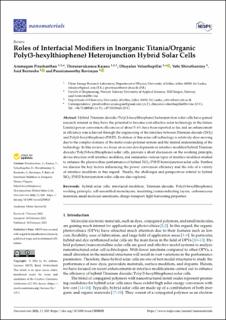Roles of Interfacial Modifiers in Inorganic Titania/Organic Poly(3-hexylthiophene) Heterojunction Hybrid Solar Cells
Pirashanthan, Arumugam; Kajana, Thirunavukarasu; Velauthapillai, Dhayalan; Shivatharsiny, Yohi; Bentouba, Said; Ravirajan, Punniamoorthy
Peer reviewed, Journal article
Published version

View/
Date
2022Metadata
Show full item recordCollections
Original version
Pirashanthan, A., Kajana, T., Velauthapillai, D., Shivatharsiny, Y., Bentouba, S., & Ravirajan, P. (2022). Roles of interfacial modifiers in inorganic Titania/organic Poly(3-hexylthiophene) heterojunction hybrid solar cells. Nanomaterials, 12(5). 10.3390/nano12050820Abstract
Hybrid Titanium dioxide/Poly(3-hexylthiophene) heterojunction solar cells have gained research interest as they have the potential to become cost-effective solar technology in the future. Limited power conversion efficiencies of about 5–6% have been reported so far, and an enhancement in efficiency was achieved through the engineering of the interface between Titanium dioxide (TiO2) and Poly(3-hexylthiophene) (P3HT). Evolution of this solar cell technology is relatively slow-moving due to the complex features of the metal oxide-polymer system and the limited understanding of the technology. In this review, we focus on recent developments in interface modified hybrid Titanium dioxide/Poly(3-hexylthiophene) solar cells, provide a short discussion on the working principle, device structure with interface modifiers, and summarize various types of interface modifiers studied to enhance the photovoltaic performance of hybrid TiO2/P3HT heterojunction solar cells. Further, we discuss the key factors influencing the power conversion efficiency and the role of a variety of interface modifiers in this regard. Finally, the challenges and perspectives related to hybrid TiO2/P3HT heterojunction solar cells are also explored
